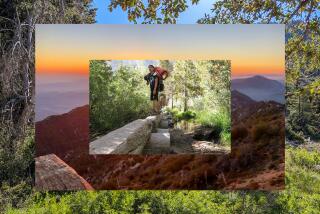Yosemite’s Camp 4 Placed on Historic Registry
Yosemite’s storied Camp 4, a birthplace of rock climbing’s modern age and an enduring mecca for the adventurous, has been honored with a spot on the National Register of Historic Places, park officials announced Thursday.
Little more than a shaggy collection of campsites encircling an antiquated cinderblock restroom, Camp 4 is for the climbing fraternity a spot as rich with history as Gettysburg. It was from this walk-in campground that climbing pioneers of the 1950s and ‘60s such as Warren Harding, Royal Robbins and Yvon Chouinard launched the first legendary assaults up the sheer walls of glaciated granite.
Veterans of the sport’s golden years happily greeted Camp 4’s new toehold in history.
“It’s way cool,” said Tom Frost, 67, who helped set some of the early routes up the face of El Capitan and other walls of rock. “It’s a personal thing for me. I spent some of the best times of my life in Camp 4 in the early ‘60s, climbing with guys on those routes up El Cap. That was a big experience for me. And it’s been a big experience for untold other climbers who have come to Yosemite to climb the walls.”
After World War II and until about 1970, Yosemite Valley was the evolutionary center of rock climbing. Camp 4, tucked against the cliffs, served as the vortex.
For decades, the campground has attracted newcomers as well as veterans from all corners of the globe eager to pitch a tent, bask in the company of peers and try Yosemite’s vertical walls.
They hobnob, swap stories and prepare for multi-day climbs, or sharpen their skills by “bouldering” on prehistoric rock slabs that sit, big as Mack trucks, amid the campsites.
During the early years, few route maps were kept and techniques now considered commonplace were just evolving.
Camp 4 served as a seedbed for the exchange of ideas, training and the development of new equipment that vastly improved the speed and safety of climbing. To this day, it remains the only place in the overbooked Yosemite Valley that does not require a reservation.
It was from Camp 4 that Harding launched his historic first ascent up El Capitan in 1957. Chouinard, who later would establish the Patagonia clothing firm, used an old anvil in Camp 4 to hammer out early versions of climbing hardware that revolutionized the sport.
“What makes this dusty little campground so historic and unique is its freewheeling, dynamic spirit and the people drawn to it over the decades,” said Linda McMillan of the American Alpine Club.
“Camp 4’s spirit epitomizes the spirit of the American West -- restless, unconventional, inventive and filled with hope.”
The historic designation sprang out of a desperate fight by the climbing community to save its venerable base camp.
After the disastrous floods of 1997 prompted Yosemite National Park officials to consider relocating housing for park employees and visitors to Camp 4, climbers rallied around their scruffy but historic patch of earth. They sued to block the development.
Ultimately, Yosemite officials opted to join with them to promote the historic designation and drop the development plans.
Russell Galipeau, Yosemite’s resource management chief, credited the climbing community with helping the National Park Service “see the history and significance of climbing and Camp 4.”
Under current plans, the existing facilities -- a ragged collection of fire pits, picnic tables and the aging bathroom facility -- are expected to be spruced up.
The number of campsites could almost double, Frost said, and the restroom will be replaced by a more modern facility. In addition, he is optimistic that a small hall where climbers can gather will be constructed.
Frost and other climbers also hope to convince Yosemite officials to embrace a proposal to create a climbing museum in the valley.
More to Read
Sign up for The Wild
We’ll help you find the best places to hike, bike and run, as well as the perfect silent spots for meditation and yoga.
You may occasionally receive promotional content from the Los Angeles Times.






